Family : Eleotridae

Text © Giuseppe Mazza

English translation by Mario Beltramini
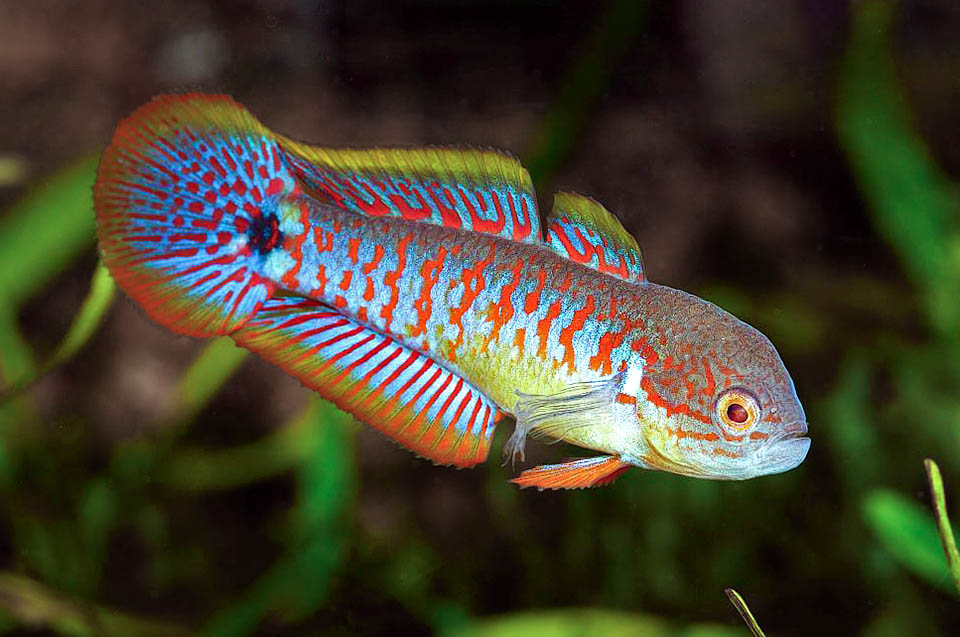
Described only in 1955, the Peacock gudgeon or Peacock goby (Tateurndina ocellicauda) is a freshwater fish native to eastern part of Papua New Guinea © Dirk Godlinski
Even if due to its splendid livery it’s commonly known as Peacock gudgeon or Peacock goby, Tateurndina ocellicauda Nichols, 1955, does not belong to the family of the Gobiidae but to that of the Eleotridae, group of tropical fish counting 23 genera and about 140 species.
They live in marine, brackish or fresh waters, and belong, they too, to the large order of the Gobiiformes.
The difference is often obvious because the pelvic fins, typically merged in the Gobiidae to form a sucker, in various Eleotridae, such as Tateurndina ocellicauda, are well separated.
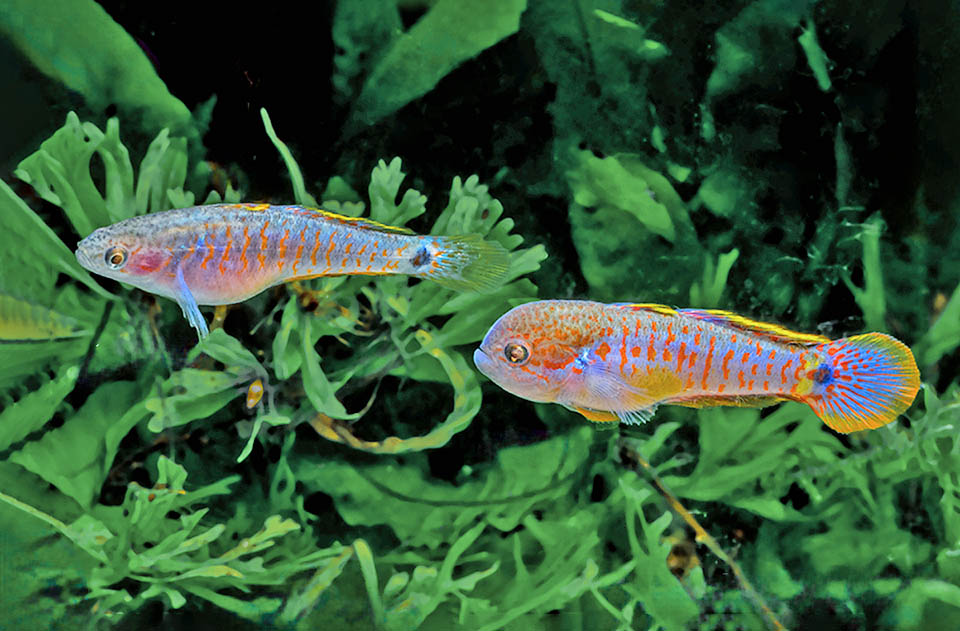
It lives in schools in the vegetation of the clear waterways of the rainforest. The maximum 7,5 cm long males, are bigger than the females with a massive head © Neli Martín
The name of the genus Tateurndina, originates from “Tate”, from “urnd” and from the adjectival suffix “-ina”, polite diminutive that recalls the beauty and the modest size of the species.
Nichols, of the American Museum of Natural History, also wanted to pay homage to the brothers George HH Tate (1884-1953), botanist and mammologist, and Geoffrey M. Tate (1898-1964), due their participation in the expeditions in New Guinea, where the holotype was collected whilst “urnd”, is thought to be referring to genus Mogurnda, fish of related appearance.
Conversely, the specific term ocellicauda is a clear reference to the characteristic black spot of the caudal peduncle.
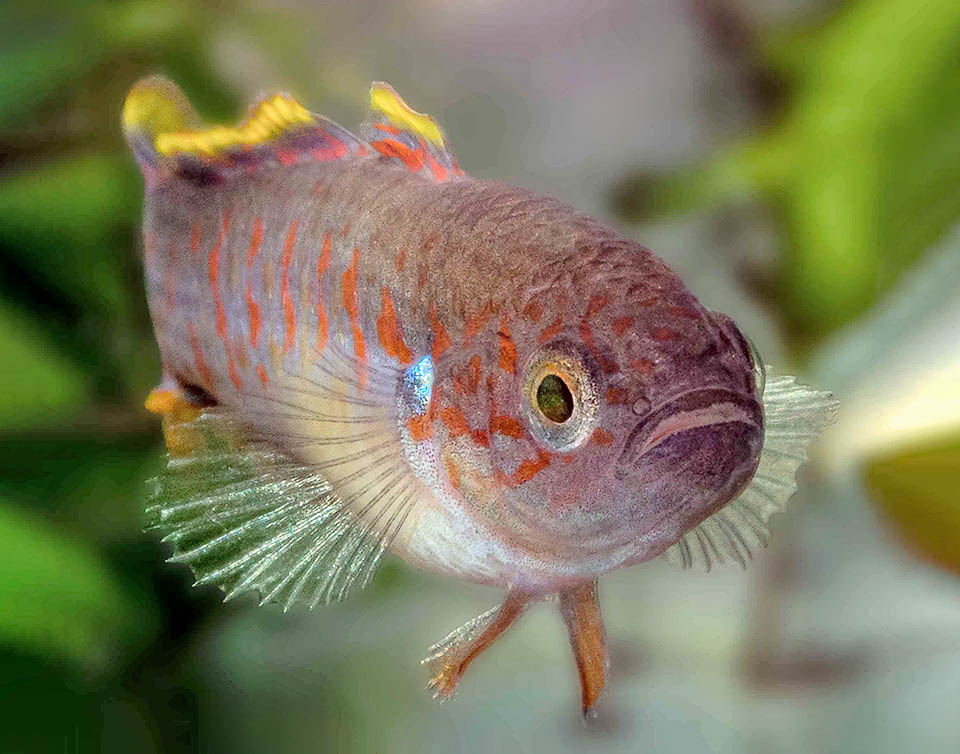
It belongs to the Eleotridae family and to the Gobiiformes order but not to Gobiidae family because the pelvic fins are not merged in the characteristic sucker © Neli Martín
Zoogeography
Tateurndina ocellicauda lives in Oceania, in the eastern part of Papua New Guinea.
Ecology-Habitat
It is not a marine fish, but a freshwater one, that swims in schools hidden by the vegetation that borders the clear waterways of the rainforest.
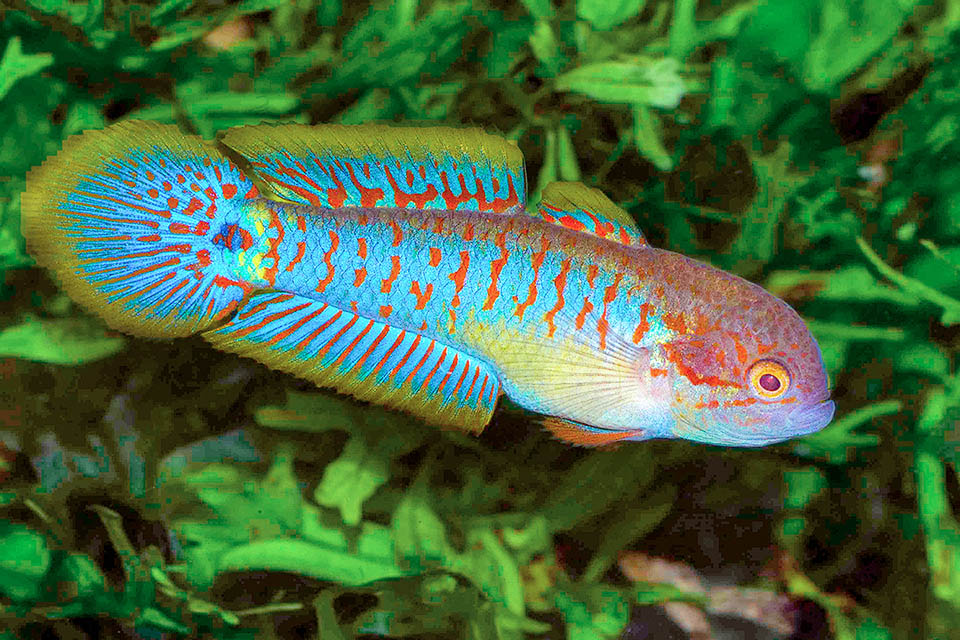
Male in its splendid nuptial livery. To lay the eggs the pairs carefully clean up the rock chosen for the nest © Neli Martín
Morphophysiology
Tateurndina ocellicauda reaches a maximum length of 7,5 cm with a fusiform body. The head of the males is massive, with conspicuous cephalic protuberance increasing with age, whilst in the females, smaller, the head is pointed and they have roundish belly, especially during the reproductive period when they are full of eggs.
There are two adjacent dorsal fins that have a total of 8-9 spiny rays and 13 soft rays. The anal has one spiny ray and 13-14 unarmed; the pectoral ones 12-14 soft and the pelvic ones are well separated.
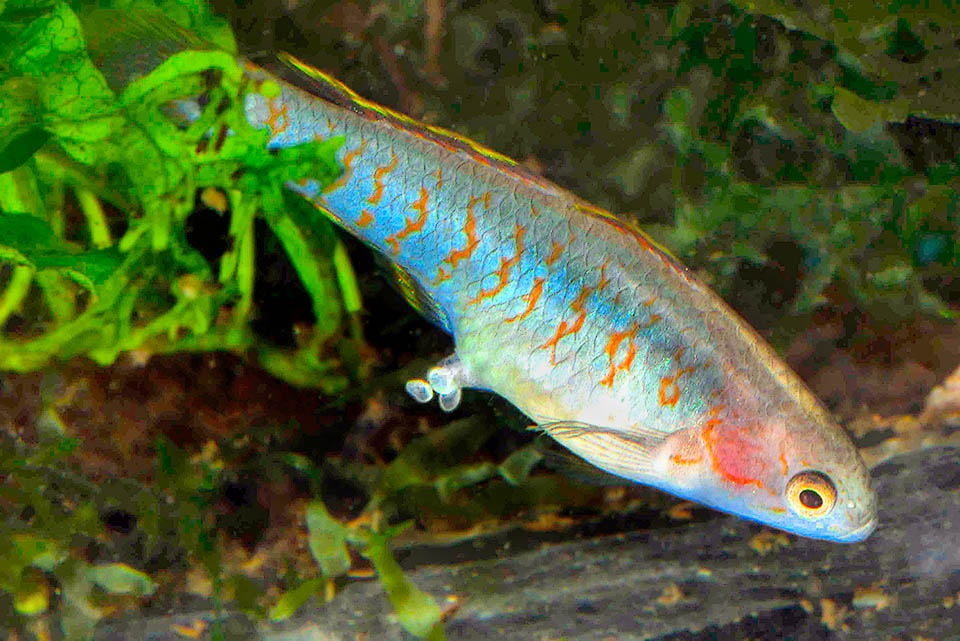
Females lay usually a twenty eggs stuck to the substratum © Neli Martín
The nuptial livery of the males is spectacular, with orange red vertical lines in a turquoise blue background. Their dorsal and anal fins bigger than those of the females end with a yellow border often emphasized by another one black.
Ethology-Reproductive Biology
Tateurndina ocellicauda feeds on plankton and on the small animals it finds on the bottoms: mostly annelids, mollusks and crustaceans. When in captivity the larvae are fed with oat microworms, and then, after about ten days, with the nauplii of .Artemia salina, Cyclops frozen or canned and finally with dry food.
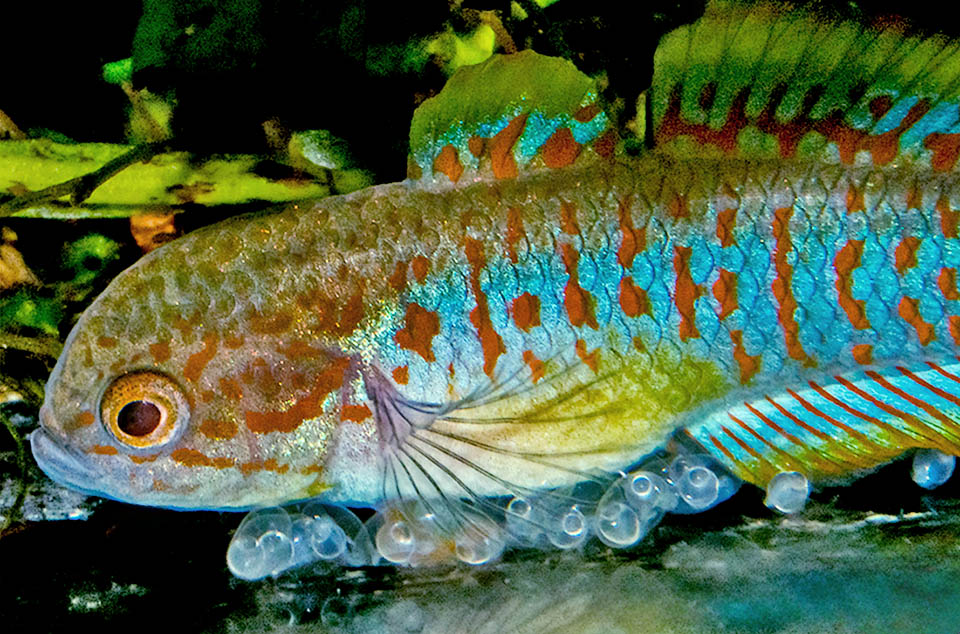
After fecundation the male stands watch until hatching, pushing away even its mate © Neli Martín
The pool can be even of modest size but they are shy fish needing rocky hiding places and a dense vegetation of aquatic plants like Anubias nana, Cryptocoryne and Java moss (Vesicularia dubyana) without forgetting the floating plants to reduce the light and to offer a shelter to the fries.
In nature, before spawning, the couples look for a not frequented site for the nest. Usually a rock they carefully clean up where the female lays about twenty eggs.
After the fecundation the male stands guard until hatching, even pushing its mate away.
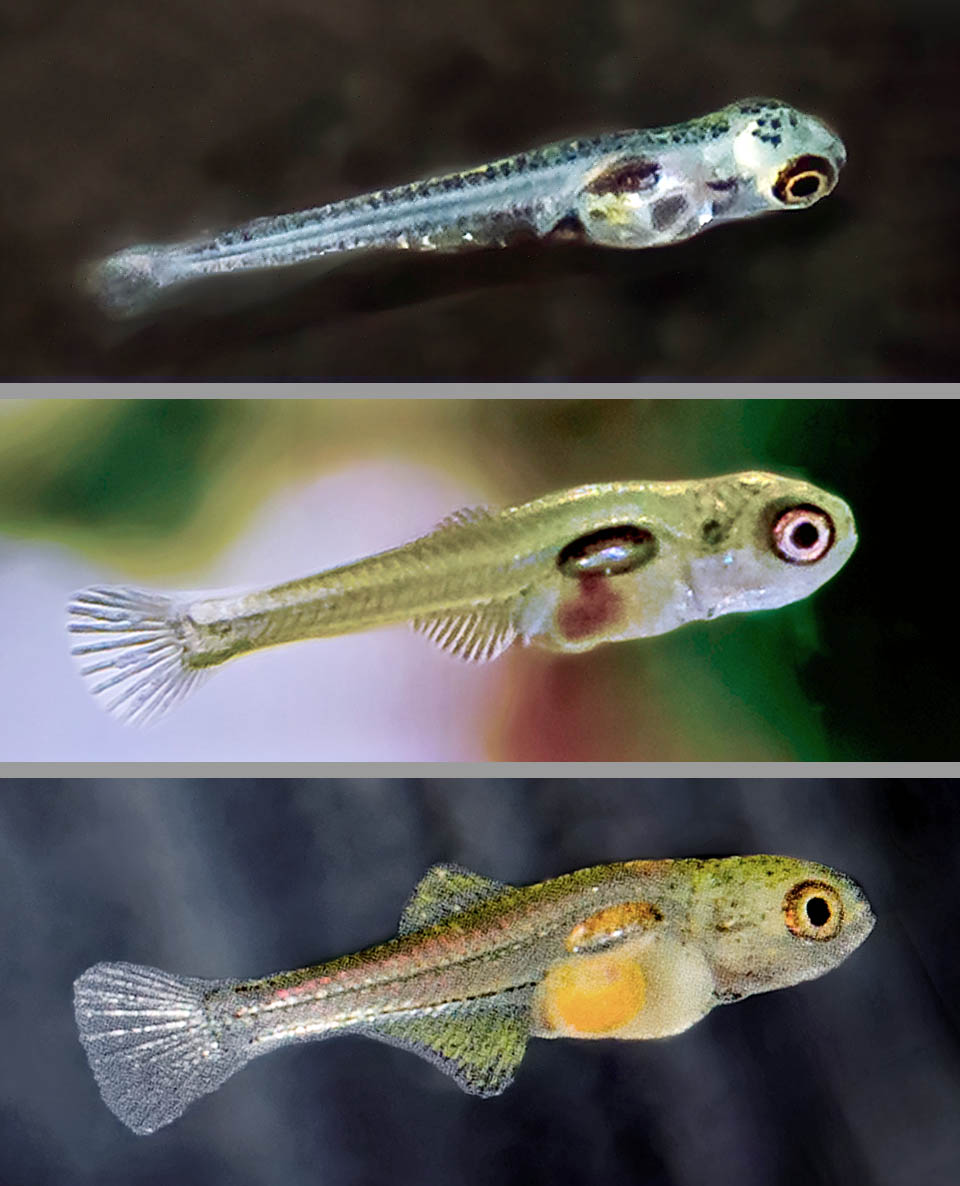
Growth of a larva when 2, 10 and 15 days old. In aquarium they feed with microworms of oats, and then with the nauplii of Artemia salina, Cyclops and finally dry food © Neli Martín
In aquariums for the nest is often provided a bamboo tube, not wider than 2,5 cm and about fifteen centimetres long, that usually they willingly adopt.
The resilience of Tateurndina ocellicauda is excellent with a possible doubling of the populations in less than 15 months, and the fishing vulnerability, very low, marks only 10 on a scale of 100.
But considering the fact that this species occupies a range less than 20.000 square km, and that the oil palm plantations and other crops are taking away more and more space from the populations, since 2029 Tateurndina ocellicauda appears as “VU, Vulnerable”, in the IUCN Red List of the endangered species.
→ For general information about FISH please click here.
→ For general information about BONY FISH please click here
→ For general information about CARTILAGINOUS FISH please click here.
→ To appreciate the BIODIVERSITY of BONY FISH please click here.
→ To appreciate the BIODIVERSITY of CARTILAGINOUS FISH please click here.
